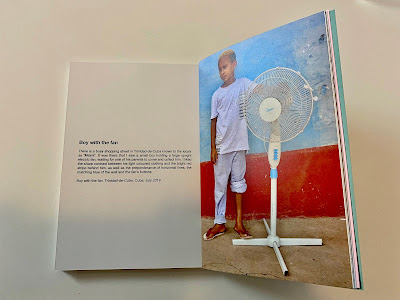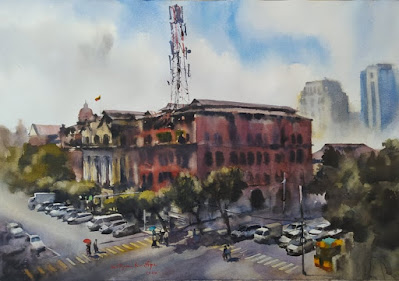A recent Adrian Yekkes post featured reviews of some of my favourite reads of 2020. It focused on five great works of contemporary fiction, all of them by Indian writers. This post continues the literary theme with five more of my favourite books from last year.

Andrew Cartmel's Vinyl Detective series is perfect for me combining music with the detective work of the unnamed hero and his fabulous partner, Nevada. Low Action is the fifth title in the series and once again the pair accept a commission to track down a rare vinyl record, the pursuit of which inevitably leads them into trouble. This time they investigate a series of attempts on the life of an ageing rock star's girlfriend, whilst simultaneously searching for a rare album of the fictional disbanded punk girl group - the Blue Tits. Low Action sees the return of several old favourites including the afore mentioned ageing rock star, Erik Make Loud, free loader Tinkler and shaved headed cab driver Agatha. I am especially fond of Agatha who gets drawn into the trickier parts of the couple's work and is admired from afar by Tinkler.
In Low Action, Cartmel works his usual magic, leading us through numerous twists and turns, developing his characters so that one feels they've known them for some time. The reader develops either a liking or disdain for each one, before reaching the final denouement which never fails to surprise. The series has great continuity with all the little habits and interests of the main characters maintained and developed with each book. The Vinyl Detective always has something to say about the quality of his coffee and Nevada can be relied upon to choose a great wine and to track down haute couture fashion in second-hand shops whilst simultaneously searching for the elusive vinyl. At the same time, there are always new subjects in his stories and trouble is sparked by all kinds of jealousies, resentments and grudges. It's worth starting at the beginning of the series if you haven't read any of them, but each title can stand alone. Cartmel has also written a number of Doctor Who novels and novellas and wrote scripts of the TV series in the late 1980's.

Still on the subject of crime, I discovered the books of A.A Dhand for the first time last year. Amit Dhand's stories, set in Bradford look at crime through the prism of various social issues including religious and political extremism, corruption and poverty but without becoming didactic or cliched.
His detective, DI Harry Virdee is a complex character who resorts to unorthodox methods to solve cases. and this often lands him in trouble with his superiors This includes occasionally securing the help of his brother who is himself involved in the city's underworld. The books also have a sub-plot. Virdee is a Sikh married to a Muslim woman. Their marriage has caused both families to sever ties with them. These mutual prejudices are to some extent examined in each of the stories but are given particular attention in his most recent novel One Way Out.
The first of his books I read was City of Sinners which left me hungry for more of his writing. Our hero is tracking a vicious serial killer bent on revenge for a perceived slight several years previously. Although he doesn't realise it at first, the grudge is somehow linked to Virdee and threatens to destroy his family. The tension builds to an almost unbearable level that kept me reading into the night, too worried to put the book down until I reached the end.
Dhand grew up in Bradford and as a teenager helped his parents in their convenience store. His experience there was no doubt a rich source of ideas for the characters and story lines of his books. He went on to qualify as a pharmacist, a profession which he still practices full-time. There are plans for Streets of Darkness, his first novel, to be made into a TV series.

Elif Shafak's 10 Minutes 38 Seconds In This Strange World was shortlisted for the 2019 Booker Prize. It is an atmospheric tale of outsiders, misfits that the city needs but doesn't want. It centres on Tequila Leila, an Istanbul sex-worker, brutally murdered and dumped in a garbage bin in the back streets of the city. The first half of the book deals with what happens to her mind after death, where for ten minutes and thirty eight seconds her life passes before her as each memory is evoked by a different smell or taste - lemons, cardamom coffee, wood and even sulphuric acid.
This device is used to take us through her life from her childhood in a small village to her escape to Istanbul where she becomes a prostitute and where her life is shaped through her relationships with her five best friends. All of them are, to some extent, outsiders. Jameelah is a Somali woman, brought to Istanbul by human traffickers. Zaynab122 (the number refers to her height) is a very religious refugee from Lebanon who is taunted for her dwarfism. Sinan is her best friend from childhood, Nalan is a trans woman and Humeyra has fled her abusive husband.
This group inhabit what was once a very diverse city and the writer's affection for those times is clear. A couple of years ago I heard her speak about how her beloved Istanbul has been cleansed of much that made it both interesting and a refuge for the dispossessed. Shafak describes the quarter in which she once lived as having a synagogue, an Armenian church, a Greek church, a Sufi lodge and a Russian Orthodox Chapel "between rows of licensed brothels" all within short distance of her street. Istanbul has also been cleansed of her presence as she now lives in the UK after having been prosecuted in Turkey for daring to refer to the Armenian Genocide in her work.
The second half of the book deals with what happens to Leila's body after her death. Her friends are not happy to let her lay in an unmarked grave where those who die in the street or without relatives are dumped. They embark on an almost slapstick mission to bury her somewhere more fitting, avoiding pursuing police as they drive through the night in a stolen truck. This is a final act of friendship and an indication of how even in death the outsider will no longer find a welcome in the city.
Shafak has a particular talent for enabling the reader to feel they are in the room with the characters. I especially felt this in the scenes in Leila's apartment and in the tension of the stifling life she lived in the village before her escape. The story examines some of her favourite themes - the treatment of women and sexual minorities, growing problems with religious and political orthodoxy and the rejection of difference. These subjects are also examined in her earlier works including The Bastard Of Istanbul, The Flea Palace, Three Daughters of Eve and Honour - all of them cracking reads.

Not many people can say that they won the Booker Prize with their first novel, but Douglas Stuart can. The Glasgow born, New York based fashion designer picked up the 2020 prize for Shuggie Bain the story of a young boy growing up in Glasgow at the beginning of the 1980's. The focus of the novel is Shuggie's relationship with his alcoholic mother Agnes and his attempts to save her from herself. In the early chapters his older brother and sister take responsibility for her but eventually leave in order to save themselves and so it's just Shuggie and Agnes from then on.
Agnes is a fascinating character. Despite living on an isolated sink estate in what was then a decaying city, she is determined to keep a clean house, to wear only the smartest clothes that show off her figure at its best, to always attend to her hair and not to go out without getting made up first. All of this despite her growing reliance on the alcohol that takes most of her weekly benefit payments. There are brief moments of respite when it looks as if everything will be fine. From time to time Agnes and Shuggie decide they will be "new" and she stops drinking, but the city, her neighbours and her need for love are always going to be there to pull her back down.
As if this isn't enough for a young boy to cope with, he is also gay. His way of speaking, attention to his appearance and disinterest in the games of other boys lead to him being described as "not right" by friends, relatives and neighbours. They also make him vulnerable to abuse by adults and older children.
Whilst Shuggie and Agnes are the main characters, there are several other stories here. Her parents have a dark secret. The female neighbours on the estate are both jealous and secretly admiring of her appearance and most of them have stories of their own with husbands made redundant in middle age and destined never to work again but still having to maintain themselves and several children. And then there's the issue of sectarianism with religious affiliation governing who will be friends with whom and where they will live, or go to school. However, despite the misery of much of their lives, Agnes and Shuggie manage moments of humour and there were occasions when I laughed out loud whilst reading this. It's a great, albeit difficult read, and good to see a novel featuring authentic working class characters receiving the highest accolades.

Avi Luria, a 73 years old retired engineer who seems to be in the early stages of dementia is the hero of Israeli writer A.B. Yehoshua's latest novel, The Tunnel. Avi's memory loss is first alluded to when he forgets to collect his grandson from school and then has trouble remembering people's first names, including that of a woman he once had a brief affair with.
His wife Dina is a high profile paediatrician who wants him to remain active and intellectually engaged in order to slow the progress of the disease. She persuades him to return to his former employer, the Israel Roads Authority as a volunteer where he becomes involved in a supposedly secret project to build a military road in the Negev Desert. The project is hampered by the road needing to pass through the location of a hill at the summit of which are ancient Nabatean ruins. Not only this, the hilltop is home to a family living in Israel but who lack appropriate documentation to do so. The family claim to be trapped and unable to live elsewhere and so Avi develops proposals to take the road underneath the hill, a costly project that will bring many technical challenges. The project gives him a new lease of life but his family are troubled by his occasionally going missing and some of his former colleagues are against his ideas.
The tunnel is a metaphor both for Avi's dementia as his world narrows and slowly darkness begins to surround him. However, perhaps all is not lost and as Dina says "Does it matter what day it is, if there is love every day". The tunnel idea is also a reference to the ongoing political situation in Israel with opportunities for resolution narrowing but then there is always light at the end of the tunnel.
You might also like Best Reads of 2020 Part One - Contemporary Indian Fiction or Essential Items And Other Tales From A Land In Lockdown - Stories From The Pandemic








































